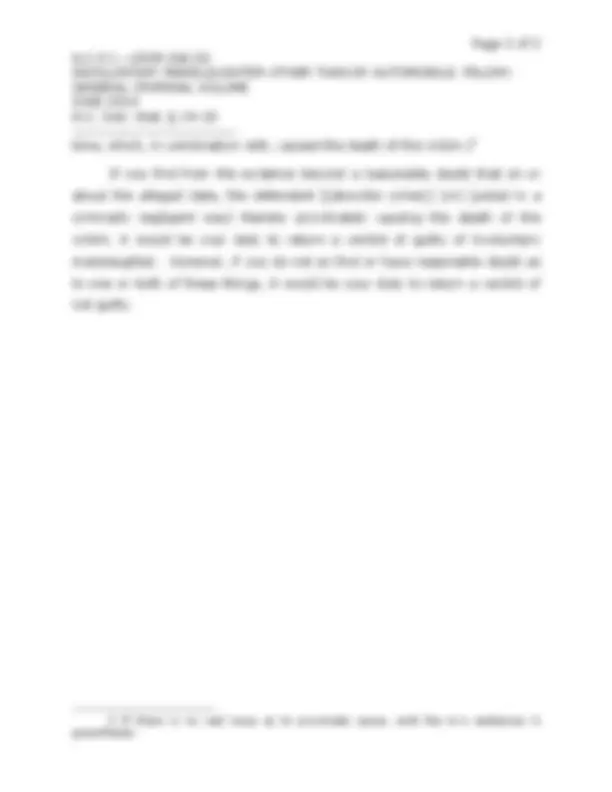



Study with the several resources on Docsity

Earn points by helping other students or get them with a premium plan


Prepare for your exams
Study with the several resources on Docsity

Earn points to download
Earn points by helping other students or get them with a premium plan
Community
Ask the community for help and clear up your study doubts
Discover the best universities in your country according to Docsity users
Free resources
Download our free guides on studying techniques, anxiety management strategies, and thesis advice from Docsity tutors
The defendant has been charged with involuntary manslaughter, which is the unintentional killing of a human being by an unlawful act not amounting to a felony ...
Typology: Exercises
1 / 2

This page cannot be seen from the preview
Don't miss anything!


Page 1 of 2 N.C.P.I.—CRIM 206. INVOLUNTARY MANSLAUGHTER-OTHER THAN BY AUTOMOBILE. FELONY. GENERAL CRIMINAL VOLUME JUNE 2014 N.C. Gen. Stat. § 14- 18
206 .50 INVOLUNTARY MANSLAUGHTER—OTHER THAN BY AUTOMOBILE. FELONY. NOTE WELL: Refer to Punishment Chart for Homicides, N.C.P.I.–Crim. 206 Series. The defendant has been charged with involuntary manslaughter, which is the unintentional killing of a human being by an unlawful act not amounting to a felony or by an act done in a criminally negligent way. For you to find the defendant guilty of involuntary manslaughter, the State must prove two things beyond a reasonable doubt: First, that the defendant acted a) [unlawfully] b) [in a criminally negligent way]. 1 a) [The defendant's act was unlawful if ( describe crime, e.g., defendant assaulted the victim (define assault). )] b) [Criminal negligence is more than mere carelessness. The defendant's act was criminally negligent, if, judging by reasonable foresight, it was done with such gross recklessness or carelessness as amount to a heedless indifference to the safety and rights of others.]^2 And Second, the State must prove that the defendant's act proximately caused the victim's death. A proximate cause is a real cause, a cause without which the victim's death would not have occurred, and one that a reasonably careful and prudent person could foresee would probably produce such [injury] [damage] or some similar injurious result. (The defendant's act need not have been the only cause, nor the last or nearest cause. It is sufficient if it ocurred with some other cause acting at the same 1 If the defendant's conduct consisted of a failure to act, this sentence should read: "First, that the defendant's failure to act [was unlawful] [constituted a criminally negligent failure to perform a legal duty]." In later portions of this instruction, the judge should modify the language as necessary to cover the failure-to-act situation. 2 In a case involving a failure to perform a duty, describe the defendant's legal duty.
Page 2 of 2 N.C.P.I.—CRIM 206. INVOLUNTARY MANSLAUGHTER-OTHER THAN BY AUTOMOBILE. FELONY. GENERAL CRIMINAL VOLUME JUNE 2014 N.C. Gen. Stat. § 14- 18
time, which, in combination with, caused the death of the victim.)^3 If you find from the evidence beyond a reasonable doubt that on or about the alleged date, the defendant [( describe crime )] (or) [acted in a criminally negligent way] thereby proximately causing the death of the victim, it would be your duty to return a verdict of guilty of involuntary manslaughter. However, if you do not so find or have reasonable doubt as to one or both of these things, it would be your duty to return a verdict of not guilty. 3 If there is no real issue as to proximate cause, omit the two sentences in parentheses.